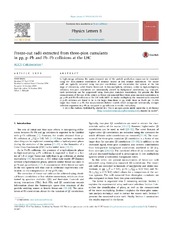Freeze-out radii extracted from three-pion cumulants in pp, p-Pb and Pb-Pb collisions at the LHC
Abelev, Betty; Adam, Jaroslav; Adamová, Dagmar; Aggarwal, Madan M.; Agnello, Michelangelo; Agostinelli, Andrea; Agrawal, Nikita; Ahammed, Zubayer; Ahmad, Nazeer; Alme, Johan; Erdal, Hege Austrheim; Helstrup, Håvard; Hetland, Kristin Fanebust; Kileng, Bjarte; Altinpinar, Sedat; Djuvsland, Øystein; Fehlker, Dominik; Haaland, Øystein Senneset; Huang, Meidana; Lønne, Per-Ivar; Nystrand, Joakim; Rehman, Attiq ur; Røhrich, Dieter; Skjerdal, Kyrre; Ullaland, Kjetil; Velure, Arild; Wagner, Boris; Yang, Shiming; Zhou, Zhuo; Arsene, Ionut Christian; Bätzing, Paul Christoph; Dordic, Olja; Lindal, Svein; Mahmood, Sohail Musa; Milosevic, Jovan; Qvigstad, Henrik; Richter, Matthias; Røed, Ketil; Skaali, Toralf Bernhard; Tveter, Trine Spedstad; Wikne, Jon Christopher; Zhao, Chengxin; Langøy, Rune; Lien, Jørgen André; Ahn, Sang Un; Ahn, Sul-Ah; Ajaz, Muhammad; Akindinov, Alexander; Aleksandrov, Dimitry; Alessandro, Bruno; ALICE, Collaboration
Peer reviewed, Journal article
Published version
Permanent lenke
https://hdl.handle.net/1956/10531Utgivelsesdato
2014-12-12Metadata
Vis full innførselSamlinger
Originalversjon
https://doi.org/10.1016/j.physletb.2014.10.034Sammendrag
In high-energy collisions, the spatio-temporal size of the particle production region can be measured using the Bose–Einstein correlations of identical bosons at low relative momentum. The source radii are typically extracted using two-pion correlations, and characterize the system at the last stage of interaction, called kinetic freeze-out. In low-multiplicity collisions, unlike in high-multiplicity collisions, two-pion correlations are substantially altered by background correlations, e.g. mini-jets. Such correlations can be suppressed using three-pion cumulant correlations. We present the first measurements of the size of the system at freeze-out extracted from three-pion cumulant correlations in pp, p–Pb and Pb–Pb collisions at the LHC with ALICE. At similar multiplicity, the invariant radii extracted in p–Pb collisions are found to be 5–15% larger than those in pp, while those in Pb–Pb are 35–55% larger than those in p–Pb. Our measurements disfavor models which incorporate substantially stronger collective expansion in p–Pb as compared to pp collisions at similar multiplicity.

